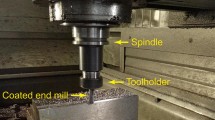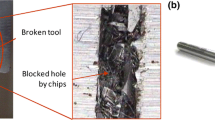Abstract
Owning to the extremely abrasive silicon particles, low melting point of aluminum, and its susceptibility to adhere to the tool, high-speed drilling of aluminum alloys containing high silicon content becomes a challenging operation. Hence, the understanding of the tool wear mechanisms is essential in order to develop and select the efficient tool material. This paper reports on the investigation of performance and wear mechanism of uncoated and TiAlN and AlTiN-coated tools when high-speed drilling of Al-Si (A383) alloy. Drilling tests were conducted at various cutting parameters, while thrust forces were measured using a dynamometer. The wear mechanisms that contributed to the drill failure were assessed by analyzing the worn cutting edge and drill bit cross section; and by employing scanning electron microscopy (SEM) and energy dispersive X-ray spectroscopy (EDX). Results showed that feed rate has the highest effect on the primary wear stage; and flank wear at the outer cutting edge found to be dominant failure mode for all tools. Moreover, it is found that plastic deformation, diffusion, attrition, abrasion, and fracture are the main operating tool wear mechanisms. The longest tool life was recorded for AlTiN-coated tool, but more adhesion of Al was observed on this tool surface. At the end, TiAlN-coated drill was proposed as the tool with the best performance among the tool materials used in this study.



















Similar content being viewed by others
Data availability
The data analyzed during the current study are available from the corresponding author on reasonable request.
References
Farid A, Ali SS, Ashrafi SA, Idris MH (2013) Statistical analysis, modeling, and optimization of thrust force and surface roughness in high-speed drilling of Al–Si alloy. Proc Inst Mech Eng B J Eng Manuf 227(6):808–820
Farid AA, Sharif S, Idris MH (2011) Surface integrity study of high-speed drilling of Al–Si alloy using HSS drill. Proc Inst Mech Eng B J Eng Manuf 225(7):1001–1007
Khan SA, Nazir A, Mughal MP, Saleem MQ, Hussain A, Ghulam Z (2017 Oct 1) Deep hole drilling of AISI 1045 via high-speed steel twist drills: evaluation of tool wear and hole quality. Int J Adv Manuf Technol 93(1–4):1115–1125
Lotfi M, Jahanbakhsh M, Akhavan Farid A (2016) Wear estimation of ceramic and coated carbide tools in turning of Inconel 625: 3D FE analysis. Tribol Int 99:107–116
Kitagawa T, Kubo A, Maekawa K (1997) Temperature and wear of cutting tools in high-speed machining of Inconel 718 and Ti-6Al-6V-2Sn. Wear 202(2):142–148
Erdel BP (2003) High-speed machining. Society of Manufacturing Engineers
Akhavan Farid A, Sharif S, Idris M (2011) Chip morphology study in high speed drilling of Al–Si alloy. Int J Adv Manuf Technol 57(5):555–564
Lotfi M, Amini S, Teimouri R, Alinaghian M (2017 Apr 26) Built-up edge reduction in drilling of AISI 1045 steel. Mater Manuf Process 32(6):623–630
Singh J, Chauhan A (2016) Overview of wear performance of aluminium matrix composites reinforced with ceramic materials under the influence of controllable variables. Ceram Int 42(1, Part A):56–81
Zhang MZ, Liu YB, Zhou H (2001) Wear mechanism maps of uncoated HSS tools drilling die-cast aluminum alloy. Tribol Int 34(11):727–731
Kishawy HA et al (2005) Effect of coolant strategy on tool performance, chip morphology and surface quality during high-speed machining of A356 aluminum alloy. Int J Mach Tools Manuf 45(2):219–227
Harris SG et al (2000) Dry machining-commercial viability through filtered arc vapour deposited coatings. Surf Coat Technol 133-134:383–388
Tönshoff K et al (1998) Performance of oxygen-rich TiAlOn coatings in dry cutting applications. Surf Coat Technol 108-109:535–542
Roy P et al (2009) Machinability study of pure aluminium and Al-12% Si alloys against uncoated and coated carbide inserts. Int J Refract Met Hard Mater 27(3):535–544
Wain N et al (2005) Performance of low-friction coatings in the dry drilling of automotive Al-Si alloys. Surf Coat Technol 200(5–6):1885–1892
Bhowmick S, Alpas AT (2008) Minimum quantity lubrication drilling of aluminium-silicon alloys in water using diamond-like carbon coated drills. Int J Mach Tools Manuf 48(12–13):1429–1443
Dasch JM et al (2009) The effect of free-machining elements on dry machining of B319 aluminum alloy. J Mater Process Technol 209(10):4638–4644
Bardetsky A, Attia H, Elbestawi M (2005) Evaluation of tool Wear suppressive ability of lubricants Usein in minimum quantity lubrication application in high speed machining of cast aluminum alloys. ASME Conference Proceedings 2005(42231):23–29
Bhowmick S, Alpas AT (2008) The performance of hydrogenated and non-hydrogenated diamond-like carbon tool coatings during the dry drilling of 319 Al. Int J Mach Tools Manuf 48(7–8):802–814
Dasch JM et al (2006) A comparison of five categories of carbon-based tool coatings for dry drilling of aluminum. Surf Coat Technol 200(9):2970–2977
Silva WM et al (2015) Performance of carbide tools coated with DLC in the drilling of SAE 323 aluminum alloy. Surf Coat Technol 284:404–409
Braga DU et al (2002) Using a minimum quantity of lubricant (MQL) and a diamond coated tool in the drilling of aluminum-silicon alloys. J Mater Process Technol 122(1):127–138
Hovsepian PE et al (2006) TiAlN/VN superlattice structured PVD coatings: a new alternative in machining of aluminium alloys for aerospace and automotive components. Surf Coat Technol 201(1–2):265–272
D’Orazio A, El Mehtedi M, Forcellese A, Nardinocchi A, Simoncini M (2017) Tool wear and hole quality in drilling of CFRP/AA7075 stacks with DLC and nanocomposite TiAlN coated tools. J Manuf Process 30:582–592
Abbas CA, Huang C, Wang J et al (2020) Machinability investigations on high-speed drilling of aluminum reinforced with silicon carbide metal matrix composites. Int J Adv Manuf Technol 108:1601–1611
Sharif S, Akhavan Farid A, Idris M (2012) Tool life prediction model of uncoated carbide tool in high speed drilling of Al-Si alloy using response surface methodology. Int J Surf Sci Eng 6(1/2):112–121
Harris SG et al (2003) A study of the wear mechanisms of Ti1-xAlxN and Ti1-x-yAlxCryN coated high-speed steel twist drills under dry machining conditions. Wear 254(7–8):723–734
Taylor FW (1907) On the art of cutting metals. Transactions of ASME 28:70–350
Astakhov VP (2006) Tribology of metal cutting. Elsevier Science
Gorczyca, F.E. (1987) Application of metal cutting theory. Industrial Press
Makarow AD (1976) Optimization of cutting processes. Machinostroenie, Moscow
Cheung FY et al (2008) Cutting edge preparation using magnetic polishing and its influence on the performance of high-speed steel drills. J Mater Process Technol 208(1–3):196–204
Lotfi M, Amini S, Al-Awady IY (2018) 3D numerical analysis of drilling process: heat, wear, and built-up edge. Adv Manuf 6:204–214
Trent, E.M. and P.K. Wright, Metal cutting. 2000: Butterworth-Heinemann
Nouari M, Ginting A (2006) Wear characteristics and performance of multi-layer CVD-coated alloyed carbide tool in dry end milling of titanium alloy. Surf Coat Technol 200(18–19):5663–5676
Jawaid A, Che-Haron CH, Abdullah A (1999) Tool wear characteristics in turning of titanium alloy Ti-6246. J Mater Process Technol 92-93(0):329–334
Devillez A et al (2007) Cutting forces and wear in dry machining of Inconel 718 with coated carbide tools. Wear 262(7–8):931–942
Nouari M et al (2005) Effect of machining parameters and coating on wear mechanisms in dry drilling of aluminium alloys. Int J Mach Tools Manuf 45(12–13):1436–1442
Carrilero MS et al (2002) A SEM and EDS insight into the BUL and BUE differences in the turning processes of AA2024 Al-cu alloy. Int J Mach Tools Manuf 42(2):215–220
Abou-El-Hossein K, Olufayo O, Mkoko Z (2013) Diamond tool wear during ultra-high precision machining of rapidly solidified aluminium RSA 905. Wear 302(1–2):1105–1112
Larsen-Basse J, Koyanagi ET (1979) Abrasion of WC-co alloys by quartz. J Lubr Technol 101(2):208–211
Bhagat RB et al (1996) Tribological performance evaluation of tungsten carbide-based cermets and development of a fracture mechanics wear model. Wear 201(1–2):233–243
Kalss W et al (2006) Modern coatings in high performance cutting applications. Int J Refract Met Hard Mater 24(5):399–404
Badisch E, Mitterer C (2003) Abrasive wear of high speed steels: influence of abrasive particles and primary carbides on wear resistance. Tribol Int 36(10):765–770
Fox-Rabinovich GS et al (2009) Design and performance of AlTiN and TiAlCrN PVD coatings for machining of hard to cut materials. Surf Coat Technol 204(4):489–496
Endrino JL, Fox-Rabinovich GS, Gey C (2006) Hard AlTiN, AlCrN PVD coatings for machining of austenitic stainless steel. Surf Coat Technol 200(24):6840–6845
Hamann JC, Grolleau V, Le Maître F (1996) Machinability improvement of steels at high cutting speeds – study of tool/work material interaction. CIRP Ann Manuf Technol 45(1):87–92
Ramaswami R (1971) The effect of the built-up-edge(BUE) on the wear of cutting tools. Wear 18(1):1–10
Acknowledgements
The authors wish to thank the Manufacturing and Production Lab of Universiti Teknologi Malaysia (UTM) for their technical supports.
Author information
Authors and Affiliations
Contributions
Ali Akhavan Farid: conceptualization, investigation, methodology, experiments, measurements, data analysis, validation, writing, and revising
Safian Sharif: supervision, conceptualization, reviewing, and editing
Mohd Hasbullah Idris: co-supervision and reviewing
Corresponding author
Ethics declarations
Ethics approval and consent to participate
Not applicable, because this article does not contain any studies with human or animal subjects.
Consent for publication
Not applicable.
Competing interests
The authors declare no competing interests.
Additional information
Publisher’s note
Springer Nature remains neutral with regard to jurisdictional claims in published maps and institutional affiliations.
Rights and permissions
About this article
Cite this article
Akhavan Farid, A., Sharif, S. & Idris, M.H. Performance and wear mechanisms of uncoated, TiAlN, and AlTiN-coated carbide tools in high-speed drilling of Al-Si alloy. Int J Adv Manuf Technol 113, 2671–2684 (2021). https://doi.org/10.1007/s00170-021-06663-w
Received:
Accepted:
Published:
Issue Date:
DOI: https://doi.org/10.1007/s00170-021-06663-w




